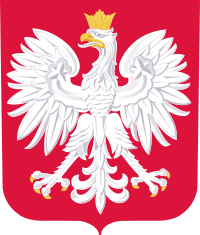History of Poland (1989–present)
In 1989–1991, Poland engaged in a democratic transition which put an end to the Polish People's Republic and led to the foundation of a democratic government, known as the Third Polish Republic (following the First and Second Polish Republics). After ten years of democratic consolidation, Poland joined NATO in 1999 and the European Union in 2004.
Part of a series on the |
||||||||||
|---|---|---|---|---|---|---|---|---|---|---|
| History of Poland | ||||||||||
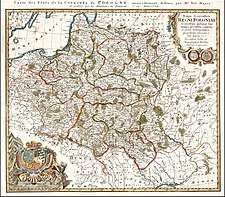 | ||||||||||
|
|
||||||||||
|
||||||||||
|
||||||||||
|
||||||||||
|
||||||||||
|
| ||||||||||
Background
Tension grew between the people of Poland and its communist government, as with the rest of the Eastern bloc as the influence of the Soviet Union faded. With the advent of perestroika in the Soviet Union under Mikhail Gorbachev, the opportunity arose to change the system of government, after the harsh period of martial law (1981-83) imposed by General Jaruzelski.
Round Table Agreement and democratic transition
The government's inability to forestall Poland's economic decline led to waves of strikes across the country in April, May and August 1988. In an attempt to take control of the situation, the the government gave de facto recognition to the Solidarity union, and Interior Minister Czesław Kiszczak began talks with its leader Lech Wałęsa on August 31. These talks broke down in October, but a new series of negotiations, the "round-table" talks, began in February 1989. These talks produced an agreement in April for partly open parliamentary elections. The June election produced a Sejm (lower house), in which one-third of the seats went to communists and one-third went to the two parties which had hitherto been their coalition partners. The remaining one-third of the seats in the Sejm and all those in the Senate were freely contested; the majority of these were by candidates supported by Solidarity. The failure of the communists at the polls produced a political crisis. The round-table agreement called for a communist president, and on July 19, the National Assembly, with the support of a number of Solidarity deputies, elected General Wojciech Jaruzelski to that office. However, two attempts by the communists to form governments failed.
On August 19, President Jaruzelski asked journalist/Solidarity activist Tadeusz Mazowiecki to form a government; on September 12, the Sejm voted approval of Prime Minister Mazowiecki and his cabinet. For the first time in more than 40 years, Poland had a government led by non-communists.
In December 1989, the Sejm approved the government's reform program to transform the Polish economy rapidly from centrally planned to free-market, amended the constitution to eliminate references to the "leading role" of the Communist Party, and renamed the country the "Republic of Poland". The communist Polish United Workers' Party dissolved itself in January 1990, creating in its place a new party, Social Democracy of the Republic of Poland. Most of the property of the former Communist Party was turned over to the state.
The May 1990 local elections were entirely free. Candidates supported by Solidarity's Citizens' Committees won most of the elections they contested, although voter turnout was only a little over 40%. The cabinet was reshuffled in July 1990; the national defence and interior affairs ministers (hold-overs from the previous communist government) were among those replaced.
In October 1990, the constitution was amended to curtail the term of President Jaruzelski. In December, Lech Wałęsa became the first popularly elected President of Poland.
Wałęsa Presidency (1990–1995)
In the early 1990s, Poland made great progress towards achieving a fully democratic government and a market economy. In November 1990, Lech Wałęsa was elected president for a 5-year term. Jan Krzysztof Bielecki, at Wałęsa's request, formed a government and served as its Prime Minister until October 1991, introducing world prices and greatly expanding the scope of private enterprise.
Poland's first free parliamentary elections were held in 1991. More than 100 parties participated, representing the full spectrum of political views. No single party received more than 13% of the total vote. The government of Prime Minister Jan Olszewski was the first fully free and democratic Polish government since 1926. This cabinet was supported by the Kaczyński brothers. Olszewski was replaced by Hanna Suchocka as the first woman Prime Minister of Poland in 1992 after Janusz Korwin-Mikke wanted all members of the Sejm who had cooperated with the communist secret police to be revealed. After a rough start, 1993 saw the second group of elections, and the first parliament to serve a full term. The Democratic Left Alliance (SLD) received the largest share of votes. Also in 1993 the Soviet Northern Group of Forces finally left Poland.
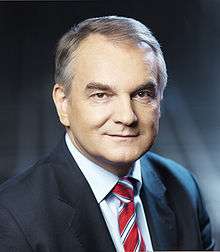
After the election, the SLD and Polish People's Party (PSL) formed a governing coalition. Waldemar Pawlak, leader of the junior partner PSL, became Prime Minister. Relations between President Wałęsa and the Prime Minister remained poor throughout the Pawlak government, with the President charging Pawlak with furthering personal and party interests while neglecting matters of state importance. Following a number of scandals implicating Pawlak and increasing political tension over control of the armed forces, Wałęsa demanded Pawlak's resignation in January 1995. A crisis resulted and the coalition removed Pawlak from office and replaced him with the SLD's Józef Oleksy as the new Prime Minister.
Kwaśniewski Presidency (1995–2005)
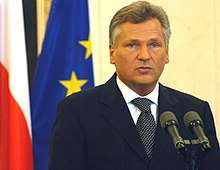
In November 1995, Poland held its second post-war free presidential elections. SLD leader Aleksander Kwaśniewski defeated Wałęsa by a narrow margin—51.7% to 48.3%. Soon after Wałęsa's defeat, Interior Minister Andrzej Milczanowski accused then-Prime Minister Oleksy of a longtime collaboration with Soviet and later Russian intelligence. In the ensuing political crisis, Oleksy resigned. For his successor, The SLD-PSL coalition turned to deputy Sejm speaker Włodzimierz Cimoszewicz — who was linked to, but not a member of, the SLD. Polish prosecutors subsequently decided that there was insufficient evidence to charge Oleksy, and a parliamentary commission decided in November 1996 that the Polish intelligence services may have violated rules of procedure in gathering evidence in the Oleksy case.
Poland's new Constitution of 1997 redefined the concept of the Polish nation in civic rather than ethnic terms. Article 35 guaranteed the rights of national and ethnic minorities, while other provisions prohibited discrimination and political organizations that spread racial hatred.[1]
In 1997 parliamentary elections two parties with roots in the Solidarity movement — Solidarity Electoral Action (AWS) and the Freedom Union (UW) — won 261 of the 460 seats in the Sejm and formed a coalition government. Jerzy Buzek of the AWS became Prime Minister. The AWS and the Democratic Left Alliance (SLD) held the majority of the seats in the Sejm. Marian Krzaklewski was the leader of the AWS, and Leszek Miller led the SLD. In April 1997, the first post-communist Constitution of Poland was finalized, and in July put into effect. In June 2000, UW withdrew from the governing coalition, leaving AWS at the helm of a minority government.
In the presidential election of 2000, Aleksander Kwaśniewski, the incumbent former leader of the post-communist SLD, was re-elected in the first round of voting, with 53.9% of the popular vote. Second place, with only 17.3%, went to Andrzej Olechowski. It is thought that the opposition campaign was hindered by their inability to put forward a charismatic (or even a single major) candidate, as well as falling support for the centre-right AWS government. This was related to internal friction in the ruling parliamentary coalition.
The 1997 Constitution and the reformed administrative division of 1999 required a revision of the electoral system, which was passed in April 2001. The most important changes included:
- the final liquidation of the party list (previously, some of the members of parliament were elected from a party list, based on nationwide voter support, rather than from local constituencies),
- modification of the method of allocating seats to the Sainte-Laguë method, which gave less premium to large parties. The latter change was reverted to the d'Hondt method in 2002.
In the September 2001 parliamentary elections, the SLD triumphed on the back of voter disillusionment with the AWS government and internal bickering within that bloc. So much so that this former ruling party did not enter parliament due to falling below the 8% threshold for coalitions. (Symptomatically, they had failed to form a formal political party, which has only a 5% threshold, and formally remained a "coalition" of parties).
The SLD went on to form a coalition with the agrarian PSL and leftist Labour Union (UP), with Leszek Miller as Prime Minister. This government had the support of 256 of the 460 seats in the Sejm.
A leading issue in the subsequent years was negotiations with the European Union regarding accession and internal preparation for this. Poland joined the EU in May 2004. Both President Kwaśniewski and the government were vocal in their support for this cause. The only party decidedly opposed to EU entry was the populist right-wing League of Polish Families (LPR).
Despite broad popular support for joining the EU, which was considered an overriding issue, the government rapidly lost popularity due to incompetence on various issues (e.g. building of motorways, and a botched reform of the health system and numerous corruption scandals). The most famous of these were the Rywin affair (an alleged attempt to interfere with the legislative process, so named after the main suspect Lew Rywin) -- this case was investigated by a special parliamentary committee, whose proceedings were televised and widely followed), and the Starachowice affair (government ministers informed friends with links to an organized crime about an impending raid).
In March some prominent SLD politicians and MPs (including the then Speaker of the Sejm: Marek Borowski) formed a split, creating the new Social Democracy of Poland party. The cabinet led by Leszek Miller resigned on May 2, 2004, just after Poland's admission to the European Union.
A new cabinet was formed, with Marek Belka as prime minister. After two initial unsuccessful attempts, it eventually won parliamentary support (24 June) and governed until the parliamentary elections in late 2005. Several of the new ministers were seen as non-partisan experts, and the government was considered a marked improvement upon the previous cabinet. This did not carry over into any rise in voter support for the SLD, however, even despite an economic upturn through 2005. Part of the reason is that this government was considered to be largely apart from the party backbone, and only held in an office by the fear of early elections by the majority of the MPs.
A fear not unfounded, as the SLD saw its support drop by three-fourths to only 11% in the subsequent elections.
Lech Kaczyński Presidency (2005–2010)
PiS-led coalition government (2005–2007)
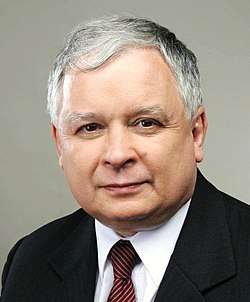
In the autumn of 2005 Poles voted in both parliamentary and presidential elections. September's parliamentary poll was expected to produce a coalition of two centre-right parties, PiS (Law and Justice) and PO (Civic Platform). During the increasingly bitter campaign, however, PiS launched a strong attack on the liberal economic policies of their allies and overtook PO in opinion polls. PiS eventually gained 27% of votes cast and became the largest party in the Sejm ahead of PO on 24%. The out-going ruling party, the socialist SLD, achieved just 11%. This continues the trend that in every free parliamentary election the Polish electorate has voted against the current government, turning to the left in 1993 and 2001, and to the right in 1997 and 2005.
Presidential elections in October followed a similar script. The early favourite, Donald Tusk, leader of the PO, saw his opinion poll lead slip away and was beaten 54% to 46% in the second round by the PiS candidate Lech Kaczyński (one of the twins, founders of the party).
Both elections were blighted by low turn-outs: only 51% in the second and deciding round of the presidential election and just over 40% in the parliamentary election. The suggested cause of the low turnout is popular disillusionment with politicians.
Coalition talks ensued simultaneously with the presidential elections. However, the severity of the campaign attacks and the willingness of PiS to court the populist vote had soured the relationship between the two largest parties and made the creation of a stable coalition impossible. The ostensible stumbling blocks were the insistence of PiS that it controls all aspects of law enforcement: the Ministries of Justice and Internal Affairs, and the special forces; as well as the forcing through of a PiS candidate for the head of the Sejm with help of several smaller populist parties. The PO decided to go into opposition.
PiS then formed a minority government with the previously little-known Kazimierz Marcinkiewicz as Prime Minister instead of party leader, Jarosław Kaczyński who remained influential in the background. This government relied on the tacit and rather stable support of smaller populist and agrarian parties (Samoobrona, LPR) to govern.
The new government enjoyed quite strong public support (which was expected during the first few months after the election), while the popularity of the populist parties giving it support, significantly waned. A parliamentary crisis appeared to loom in January 2006, with these small populist parties fearing that PiS was about to force new elections (on which they would lose out) by using the pretext of failing to pass the budget within the constitutional timeframe. However, a crisis was abated.
In May 2006 a coalition agreement for the majority government was formed between PiS, Samoobrona and League of Polish Families (LPR). In July 2006, following a rift with his party leader, Jarosław Kaczyński, Marcinkiewicz tendered his resignation as Prime Minister and was replaced by Jarosław Kaczyński. The following 15 months were erratic and not without controversy, as the government pursued lustration policies, established a Central Anticorruption Bureau with far-reaching powers and was embroiled in a case relating to the suicide of an MP who was under investigation for corruption. The new government also modified Polish foreign relations relating to the EU by adopting a more eurosceptical stance, where Polish governments had in the past adopted a very pro-EU position.
The uneasy alliance between the three coalition partners came to a head in July 2007 when Samoobrona leader, Andrzej Lepper, was dismissed from his position as Minister for Agriculture following a secret investigation by the Central Anticorruption Bureau (CBA) which attempted to link him and his department to corruptive practices. Lepper protested his innocence and claimed to have been the victim of a politically motivated 'sting' operation, initiated by PM Kaczynski and PiS. The coalition agreement collapsed over the following month, with both the LPR and Samoobrona levelling accusations against PiS. In September, the Sejm voted to dissolve itself (supported by PiS but opposed by Samoobrona and LPR), paving the way for elections in October.
Donald Tusk government (2007–2014)
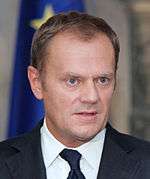
In the October parliamentary elections, the Civic Platform (PO), the largest opposition party, gained more than 41% of the popular vote. PiS's vote increased, from 2005, but insufficiently to gain reelection, whilst both Samoobrona and LPR were wiped out, losing all representation, each having gained only a little over 1% of the vote. PO proceeded to form a majority governing coalition with the agrarian Polish People's Party (PSL), with PO leader, Donald Tusk, taking over the prime ministerial office in November 2007.
On August 14, 2008, the United States and Poland agreed to have 10, two-stage missile interceptors - made by Orbital Sciences Corp - placed in Poland, as part of a missile shield to defend Europe and the US from a possible missile attack by Iran. In return, the US agreed to move a battery of MIM-104 Patriot missiles to Poland. The missile battery would be staffed - at least temporarily - by US Military personnel. The US also pledged to defend Poland - a NATO member - quicker than NATO would in the event of an attack. After the agreement was announced, Russian officials - who view the missile shield as a threat - released a statement indirectly threatening Poland, and said that the missile defence system would greatly harm future US/Russia relations.[2]
Russia later threatened nuclear attack against "new US assets in Europe",[3] referring to Poland. The US has pledged to back Warsaw in the event of Russian aggression towards Poland.
Komorowski Presidency (2010–2015)
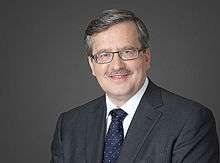
On 10 April 2010, numerous high-ranking Polish statesmen died in the Smolensk air crash, including Lech Kaczyński, the President of Poland at the time. At the 2010 Polish presidential election, Donald Tusk decided not to stand. At PO primary elections, Bronisław Komorowski defeated the Oxford-educated Foreign Minister Radosław Sikorski, at the second round of voting on 4 July 2010, he defeated PiS's Jarosław Kaczyński.[4] and on 6 August 2010 he was sworn in as president. At the November 2010 local elections, PO won 31 percent of the votes and PiS 23 percent, an increase for the former and a drop for the latter compared to the 2006 elections.
In October 2011, Donald Tusk, with a clear pro-European agenda, became the first ever Polish Prime Minister to be re-elected in post-communist Poland. PO won a record of four consecutive elections, and Donald Tusk was left as the kingmaker. PO's dominance was seen as a reflection of right-wing weakness and divisions, with PiS splitting in autumn 2010.[4]
Duda Presidency (2015–present)
After two rounds of elections in May 2015, opposition Law and Justice (PiS) candidate Andrzej Duda became president by a 3% margin.[5] In October 2015, the PiS won the simple majority in the Sejm, was able to form the first single-party government since the fall of communism in 1989.
Since the PiS control the presidency and have the majority in both houses, it aims to make judiciary reforms in the Constitutional Court. See Polish Constitutional Court crisis, 2015.
The ruling party has been accused of leading Poland towards democratic backsliding. The state media is now considered the mouthpiece of the government by many, and independent media outlets are facing increasing dangers. The government has also opted for changing the narrative of the Holocaust, what has been described as a threat to academic freedom.[6]
See also
References
- Kamusella, Tomasz. "Poland's Minorities in the Transition from Soviet-Dominated Ethnic Nation-State to Democratic Civic Nation-State". Retrieved 20 December 2009.
- Bloomberg.com
- Telgraph.co.uk
- Warsaw Business Journal Archived 2010-12-20 at the Wayback Machine
- "Conservative Duda wins Poland's presidential vote". Al Jazeera. 25 May 2015. Retrieved 25 February 2016.
- https://freedomhouse.org/country/poland/freedom-world/2020
External links
- Commonwealth.pl, Commonwealth of Diverse Cultures: Poland's Heritage
- U.S. State Department State.gov, Background Note: Poland
- Russia threatens nuclear attack on Poland over US missile shield deal - Telegraph - Telgraph.co.uk
